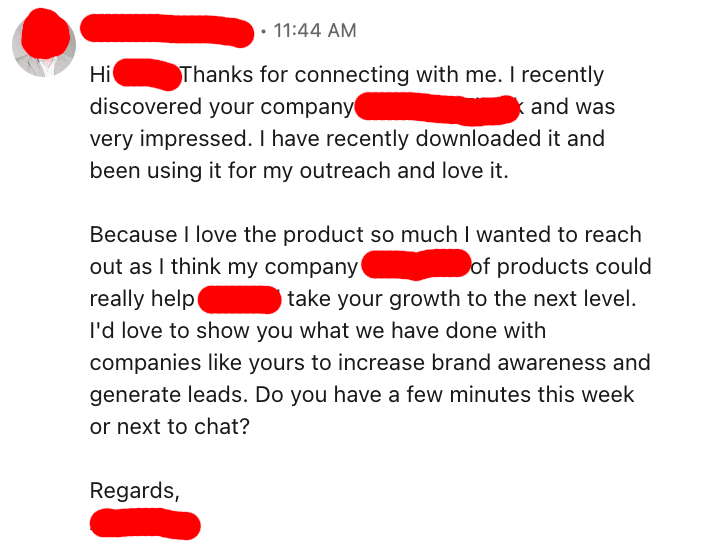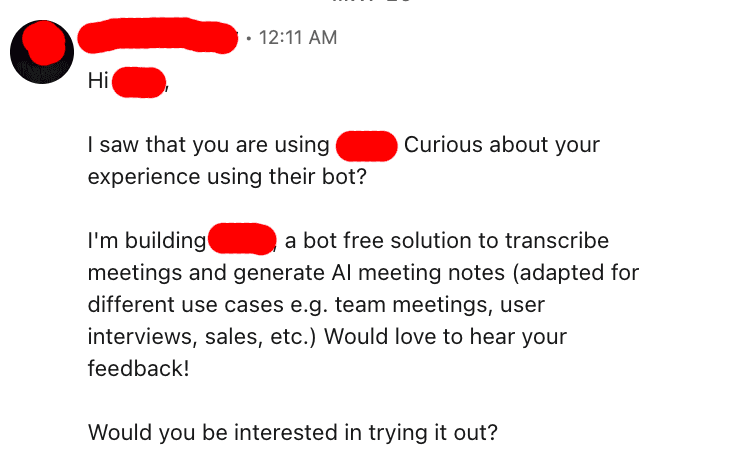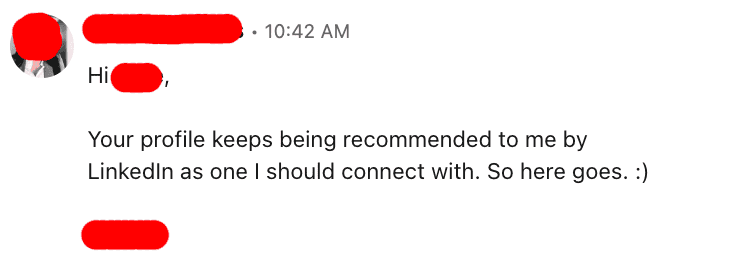Oh, LinkedIn. It's not just a digital abode for your resume anymore, but a full blown social network that is ripe for prospecting and cold outreach. (Each profile on there is like a juicy piece of fruit, ready to be picked.) With more than 500 million professionals waiting to be wowed by your compelling message, it could just be the best shot you've got at growing your client database, finding new customers, and making more of those sweet deals.
Why use LinkedIn for prospecting and cold outreach?
Still wondering if you should take LinkedIn seriously? Chew on this for a moment: 76% of B2B buyers are ready and willing to have a chat about business via social media. That's correct, folks, three-quarters of your target audience are lurking on LinkedIn, probably sipping their morning coffee, swiping away at those boring old outreach messages. (You’re probably even doing this too!)
So, the question begs: How do we make our message stand out and get 'em to hit the "reply" button instead of the "delete" one? Well, buckle up, because we're about to dish out LinkedIn prospecting messages template, LinkedIn cold outreach templates, and some best LinkedIn sales navigator practices.
How to craft effective LinkedIn messages
Starting a conversation with someone is a lot easier if you've got something interesting to share. And that holds true even on LinkedIn. Before you even begin crafting your message, think about what you want to say and why it would matter to the reader. Are you offering them a job opportunity? Do you have insightful industry news to share? Or maybe you read one of their articles and found it helpful or intriguing. A message that brings some kind of value to the receiver, beyond a simple hello or introduction, is likely to get their attention and, hopefully, a reply.
Keep it friendly
While LinkedIn is a professional platform, that doesn't mean you have to come across as if you're delivering a keynote speech at a board meeting. Nobody likes dealing with a robot (well, almost no one). Your message should still sound like it came from a living, breathing human being who understands emotions - not a cold storefront. Start with a relaxed greeting, use the receiver's name to show that this is a personal message and not a mass template, and maintain a polite, friendly tone throughout.
Be concise
We've all got inboxes groaning under the weight of unread messages and frankly, nobody's got time to read a novella on LinkedIn. Keep your message brief and focused. Don't ramble or go off on tangents. If there’s a particular point you want to get across, do it straight away and avoid the urge to add fluff. Bullet points and short sentences can help keep your message compact and easy to read. Remember, your goal is to engage, not bore.
Make it relevant
Always consider the 'so what?' factor when drafting your LinkedIn message. Anyone who reads your message should quickly see what’s in it for them. Tailor your content in such a way that it speaks to the reader's interests or needs. If you're reaching out to someone in a particular industry or job role, relate your message to that. The more relevant your message seems to the receiver, the more likely they are to respond. (Which is also why a tool like Magical is great, because it lets you automatically personalize your templates based on information from their LinkedIn profile. Woah.)
Remember: It’s just an opening for conversation
Finally, your LinkedIn message should be the first step in a conversation, not an end in itself. Make sure you end your message in a way that invites a response. You could ask an open-ended question, propose a meeting, or simply say that you're open to discussing the topic further. If you leave the ball in their court, it's more likely they'll hit it back.
Use the Magical AI Template Generator to create LinkedIn messages for you
Not sure what you want to say? Use this Magical template generator to create a custom template for your LinkedIn outreach or prospecting messages. You can get specific with your prompt (for example, you can ask for 'a LinkedIn message template asking if the recipient is happy with their SEO services’) and even choose the tone of voice you want to use. To generate an unlimited number of email templates, add the free Magical Chrome extension to your browser.
{{ai-generator="/ai-template-generator"}}
5 LinkedIn message templates for prospecting
As you engage in the art of prospecting, remember that it's not about digging for gold, it's about starting meaningful conversations. Let's explore five templates that can help you garner those golden opportunities:
1. Shared interest connection
"Hey [Name], in perusing LinkedIn, I noticed we both have a passion for [shared interest]. Being in the same field, I bet we could both get a lot of insights out of a quick chat. Let me know if you’re interested. Best, [Your Name]"
This template is effective as it identifies a mutual interest. By initiating a connection based on shared enthusiasm, you're tapping into the emotionality of human interaction, which can jump-start an open and genuine conversation.
2. Local industry connection
"Hi [Name], your profile caught my eye because, like me, you're also contributing to the [industry] in [city]. Given our similar professional landscapes, I thought it could be beneficial for us to connect. How about we have a chat to learn more about each other's experiences? - [Your Name]"
This template is relatable and region-specific. Connecting with local professionals in the same industry can foster a sense of community, making this approach more likely to resonate and evoke a positive response.
3. Content appreciation connect
"Hello [Name], I recently read your article on [specific topic] and found your insights quite enlightening. It’s refreshing to meet others who are passionate about [field/industry]. I believe connecting with you could lead to some interesting conversations. Looking forward to hearing your thoughts. Best, [Your Name]"
Complimenting and referencing someone's work is an excellent way to show you've done your homework and genuinely appreciate their expertise. This kind of personalized approach suggests a mutual interest in the subject and can spark meaningful discussions.
4. Event-based introduction
"Hi [Name], I noticed we both attended the [specific event/webinar/conference]. It’s great to connect with fellow attendees to exchange thoughts and reactions. Let's connect and share our takeaways from the event. Best, [Your Name]"
By referencing a shared event, you highlight a common experience, thereby making your message relevant and timely. It allows for an organic connection based on mutual involvement, offering a strong foundation for a conversation.
5. Recommendation referral
"Hello [Name], [Mutual connection name] highly recommended that I reach out to you. Given our shared interest in [industry/topic], I believe there’s a great scope for learning and collaboration. Would you be open to connecting to discuss further? Best, [Your Name]"
Leveraging mutual connections adds credibility to your effort to reach out. This kind of message also reassures the recipient that the outreach is based on careful thought and genuinely shared interests or opportunities. It makes the introduction feel more natural and less like a cold reach out.
8 LinkedIn message templates for cold outreach
Reaching out to a prospective client for the first time can be akin to treading on thin ice; you need to have balance, precision and, above all, you've got to keep it cool. Here are five templates that'll help you make that first impression a laudable one.
1. Common connection introduction
"Hi [Name], [Mutual connection's name], whom we both know well, suggested that I reach out to you. Given that our businesses both operate in [industry] and serve similar clientele, it seems like there could be potential for a beneficial rapport. Would you be open to a brief call or a meeting to explore this possibility? Regards, [Your Name]"
Citing a mutual connection infuses credibility into your cold outreach and converts it into a warm one. Leveraging an existing relationship can act as a trust bridge and create an openness to discussion.
2. Pertinent problem solver
"Hello [Name], I've recently been following your updates and noticed that [specific problem*] might be a concern for your team. At [Your Company], we've helped similar companies in [industry] address this issue effectively. I'd love to share how we achieved this. Do you have some time this week for a quick chat to discuss? Best, [Your Name]"
Identifying a potential challenge in their business and suggesting a solution piques their interest right away. This approach shows you've done your research and that you’re genuinely interested in helping their business.
3. Engaging enthusiasm
"Hi [Name], I was genuinely enthusiastic after going through your company’s updates and seeing the fresh yet effective approaches you're employing in [industry]. I’d love to understand more about your initiatives and see if we can add value to them at [Your Company]. Can we arrange a time to chat this week? Best, [Your Name]"
Genuine enthusiasm and appreciation for their work can break down barriers. Everyone appreciates recognition, and showing you’re interested in their unique approaches could pique their curiosity about yours.
4. Direct approach with discretion
"Hello [Name], as a [Your Position] at [Your Company], I work with companies like yours in [industry] to [insert a one-liner about your offerings]. I would appreciate the opportunity to learn about your challenges and share how we might be able to address them. Can we schedule a discussion? Best, [Your Name]"
This straight-to-the-point approach is respectful of their time, informing them instantly about your area of expertise and the potential benefits of your offerings.
5. Recent content trigger
"Hi [Name], I recently came across your post/article about [topic] and it resonated with the work we do at [your company]. I'd love to exchange ideas about [specific idea]. Would you be open to a call next week to chat? Cheers, [Your Name]"
Highlighting their recent content shows that you’re engaged with their work and that your outreach is relevant and timely. It also eliminates the cold part of cold outreach, as it can act as a conversation starter based on their recent thoughts or ideas.
6. Personalized accomplishment
"Hi [Name], I noticed you recently [published a book/delivered a talk/won an award. Congrats on that! I'd love to be able to learn a little more about that. Would you be interested in connecting over a call?"
This message shows you've done more than just copy/paste a mass marketing message. You've spent the time to learn something specific about them and called it out. This praise builds an authentic relationship whether or not you choose to push them to a call.
7. Common interest intro
"Hi [Name], I see we both went to [Insert school/college name here. I'd love to connect!"
"Hi [Name], I see we both volunteer at [Insert Here.] Open to connecting and getting to know each other?"
"Hi Name], I'm trying to expand my connections of people working in [insert job field here] right now. Would love to chat a bit about what you do!"
"Hi [Name], I just moved to [Insert area here] and I'm trying to build my network of other [insert industry] professionals. Can we connect over a virtual coffee?"
These templates are winners because it's highly personalized, but is also very likely to get a connection request approval and even a follow up message. There are so many directions you can take this one that it should keep you busy with outreach for awhile!
8. Looking for interviews/quotes with experts
"Hi [Name], I'm [insert role here. Example: a freelance writer, a blogger, a podcast host, a Facebook group manager] looking to find experts to come give a workshop to my community/interview on my podcast. I found you through [insert method/location here.] I think your expertise on [subject] would be highly valuable for my audience. Would you be open to a quick call to learn more?"
The flattery in this one works well, but it also shows you've done your research and understand the person's area of expertise. Many people love talking about their field of interest!
5 Templates for Hiring, Networking, and Recruiting
1. Building a startup team
"Hi [Name], I'm really impressed with what you're doing over at [Insert Company Name Here. I loved reading about it recently in [Place.] Company XYZ has plans to launch something new soon and your expertise might be just what we need. Would you be open to talking?"
2. General recruiting
"Hi [Name], I was recently browsing your [website/LinkedIn profile] and noticed the great work you're doing with [Project.] The work you're doing there is exactly what XYZ Company is looking for. Would you be open to connecting about the opportunity?"
3. Connecting with a recruiter or hiring manager
"Hi [Name], I found your information on [Where.] I am currently looking for a new opportunity to gain experience and sharpen my skills in a [position type] role. Right now, I work for [Company] doing [Role], but I am also interested in applying for the open position at [Hiring company."
4. Looking for internship opportunities
"Hi [Name], I'm a current [Insert role or student year.] I'm looking for internship opportunities in your field. Specifically, I'm interested in growing my skills in [insert skills here.] I'd love to connect with you about any available internship opportunities with your company or network.
5. Looking for mentoring opportunities
"Hi [Name], I found your information on [Where.] I'm currently looking to grow my network in [field.] Here's what I'm looking for [share details about what you're seeking in a mentoring relationship.] Would you be open to a brief call to discuss?"
5 Best Practices for LinkedIn Sales Navigator
Navigating LinkedIn Sales Navigator can feel like trying to solve a Rubik's cube without some directional pointers. Well, fear not; here are five pearls of wisdom to help you steer the ship confidently:
1. Maintain the human touch
Even though we're working in a digital realm, let's not forget: we're human, and so are your potential leads. Therefore, it's essential to ensure the tone of your messages resonates on that human level. Treat the platform as you would a business mixer or a networking event. Write your messages as if you're chatting over a cup of coffee. Be casual, friendly, and personable - there's a real person on the other end reading your message, so make sure it sounds like it came from a real person too.
2. Maximize the use of advanced search
The Advanced Search on LinkedIn Sales Navigator isn't called "advanced" for nothing - it's like a futuristic GPS that can directly guide you to your ideal leads. This tool enables you to narrow down your search using specific filters, thereby helping you to hit the bulls-eye within your target market. Be it industry, company size, function, seniority level, or even geographical location, advanced search can refine your search towards those who hold the most potential for your business.
3. Tap into lead recommendations
LinkedIn's algorithms aren't just sitting around eating silicon chips. The platform uses them to swoop through the vast network and serve you daily lead recommendations. Don't ignore these; they’re leveraged from your sales preferences, search history, and profile interactions, which means they're tailored 'just for you'. Treat these recommendations as your personal lead concierge presenting a curated list of potential contacts.
4. Stay current with lead updates
Time stands still for no one, and your leads are no exception. Keep up with the Joneses by regularly checking your feed to stay informed about updates from your saved leads and accounts. Perhaps they recently won an award, published an article, or made a significant business move. Reacting to these updates by sending a congratulatory message or a thoughtful comment can place you in their radar and foster a meaningful interaction.
5. Dive deep with premium insights
LinkedIn Sales Navigator lets you peek behind the curtain with its premium insights feature. This nifty tool provides rich, detailed insights on saved accounts, including growth trends, hiring trends, and departmental structure within larger companies. Harness this data mine to understand your target accounts better and to customize your outreach strategies accordingly.
3 examples of successful LinkedIn cold messages
What's better than some real-life examples to bring this all to life? Let's jump into three examples of successful cold messages we've seen land those tricky outreach conversions.
Example 1: Flattery will get you far in life

Example 2: Poaching leads from a competitor

Example 3: KISS (Keep it simple, stupid)

How to use LinkedIn cold outreach templates with Magical
Templates are the beginning, not the end. With the free Magical Chrome extension, you’ll be able to save all your templates in one place, call them up in the blink of an eye, and instantly personalize them based on the LinkedIn profile you’re messaging. It's the fastest way to start up an automated messaging on LinkedIn workflow.
Here’s how it works:
Download the free Magical Chrome extension
Add in your favorite templates (or use Magical AI to draft your templates for you!)
Add in placeholders for specific details like {First Name} or {Company Name}
When you’re ready to message, just type in “//” in the message box to pull up all your templates on LinkedIn.
Choose the one you want, and watch and be amazed as it instantly fills in your placeholders with the recipient’s information.
Using Magical, you can speed up your outreach to message dozens more people in a single day. Salespeople using Magical save an average of seven hours per week on repetitive tasks like messaging.
5 tips for prospecting on LinkedIn messages
Lucky for you, we've got your back with a few ace tips to up your LinkedIn messaging game.
1. Take the time to personalize
It's kind of like making a scarf for your friend. Sure, you could buy one, but knitting one yourself says you care.
2. Value first, sell later
Imagine sitting down for a coffee and your companion immediately starts selling you a vacuum cleaner. Awkward, right? Don’t be that person. Aim to provide value first, before venturing into sales territory. This could mean sharing an insightful article, commenting on their recent post or providing a solution to a problem they might be facing. This soft approach not only establishes credibility, but it also paves the way for fresher, deeper conversations down the line.
3. Keep it short and sweet
When you're prospecting through LinkedIn messaging, remember you're not writing 'War and Peace.' Keep your messages brief but meaningful. No one has time to scale a mountain of text. Aim for 50 to 100 words max. Short, concise messages are more likely to capture attention and encourage the reader to respond.
4. Play the curiosity card
Don’t spell out everything in the first message. Intrigue is a powerful tool. Perhaps you have an idea you think could greatly benefit their business or a unique insight into their industry. Teasing it in your message would likely pique their interest, making them want to engage further with you to learn more.
5. Follow-up, but don’t talk
You sent the message, but there's no reply yet? Don't sweat it. People are busy, and they might forget to respond. It's absolutely okay to send a gentle follow-up after a week or two. However, there's a fine line between being persistent and becoming a nuisance. If they don't reply after two or three attempts, it’s best to move on to the next prospect.
Conclusion
Remember: LinkedIn is more than just your online resume. If navigated cleverly, this platform can revamp your marketing strategies and boost your conversion rates. Spend some time crafting your message, embracing the unique qualities of this platform, and incorporating our tips and templates. Remember, rejection isn’t defeat; rather, it’s a step towards refining your approach.
